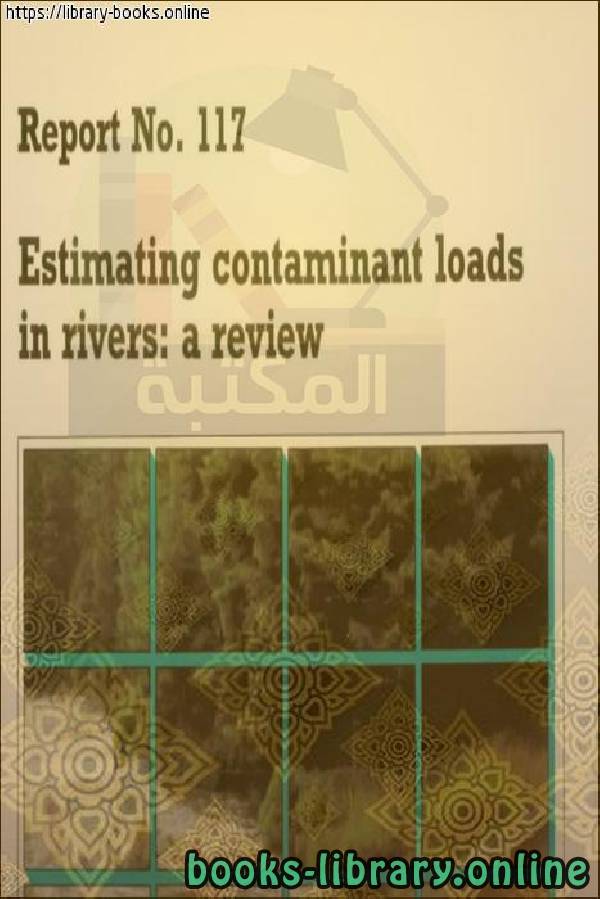📘 قراءة كتاب Estimating Contaminant Loads in Rivers-Centre for Ecology أونلاين


Biologically
Biology is a natural science that is concerned with the study of life, its various forms and its function, how these organisms interact with each other and with the surrounding environment. The word biology in Greek is made up of two words: bio (βίος) meaning life. And loggia (-λογία) means science or study. Biology: the similarity of vegetation and animal cover on the edges of the African and American states, and the existence of the same fossil.
Branches of biology
Biology is an ancient science thousands of years old and modern biology began in the nineteenth century. This science has multiple branches. Among them are:
Anatomy
Botany
Biochemia
Biogeography
Biofisia
Cytology or cell science
Ecology or environmental science
نبذه عن الكتاب:
Executive summary
As the debate on probable and possible anthropogenic impacts on the natural
environment becomes more scientific and intemational, the need has increased for
reliable information concerning the magnitude and trends of mass loads carried by rivers through estuaries to the sea. River load information is also required to assist
with the management of inland waters, environmental investigations and research into
hydrochemical processes. This report reviews river mass load estimaton procedures with partcular reference to UK conditions.
According to the sampling strategy and calculation method employed, river load
estimates can be highly variable in terms of their accuracy and precision. Low
frequency sampling at regular intervals, combined with simplistic computational algorithms, can result in heavily biased and imprecise load estmates. Often, significant improvements can be obtained by exploiting 'continuous' flow records in
the computational algorithm. At sites with a flashy hydrological response, and for
determinands with a high coefficient of variation for concentration (e.g. suspended sediment), there may still be large errors if the sampling frequency is low (e.g. once
or twice per month).
Levels of bias and precision in mass load estimates depend on many factors: the
hydrological and hydrochemical dynamic responses at the site and for the
determinand in question; calculation algorithm; sampling interval; length of
estimation period; and measurement errors (systematic and random). No single combination of sampling frequency and calculation algorithm can be devised which
will return load estimates of a prescribed quality for all sites and determinands. It
may be necessary to consider a 'worst-case' determinand when setting the sampling
strategy at a given site; often this will be suspended sediment.
Wherever a 'continuous' record of streamfiow is available covering a period of sparse concentration data, a mathematical relationship between flow and concentration
should be sought from which concentrations at non-sampled times can be estimated.
Periods of relatively frequent sampling should be undertaken to quantify the flow - concentration relationship. The transfer function model, rather than the linear
regression model, deserves much more attenton in this respect. Other mathematcal
models, particularly those where the focus of attention is hydrograph separation into
components with characteristic concentrations, could lead to improvements in river
loads estimation. Wherever funds permit, flow-proportional or probability sampling using automatc sampling devices should be adopted. The report outlines briefly the
problems which can arise in calculating river loads of determinands which are
sometimes recorded as 'less than' values.
Biology
Human biology
Who is the founder of biology?
The importance of biology
Areas of work in the field of biology
Theories of biology
Research on biology for the first grade of secondary school
Human biology
سنة النشر : 1992م / 1412هـ .
حجم الكتاب عند التحميل : 3.233 .
نوع الكتاب : pdf.
عداد القراءة:
اذا اعجبك الكتاب فضلاً اضغط على أعجبني و يمكنك تحميله من هنا:

شكرًا لمساهمتكم
شكراً لمساهمتكم معنا في الإرتقاء بمستوى المكتبة ، يمكنكم االتبليغ عن اخطاء او سوء اختيار للكتب وتصنيفها ومحتواها ، أو كتاب يُمنع نشره ، او محمي بحقوق طبع ونشر ، فضلاً قم بالتبليغ عن الكتاب المُخالف:
 قبل تحميل الكتاب ..
قبل تحميل الكتاب ..
يجب ان يتوفر لديكم برنامج تشغيل وقراءة ملفات pdf
يمكن تحميلة من هنا 'http://get.adobe.com/reader/'


 منصّة المكتبة
منصّة المكتبة 